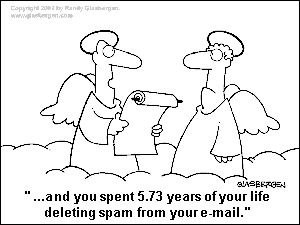|
Who Cooked This Up!?
(How did Internet Spam get its name?)
The modern meaning of the word "spam" has
nothing to do with spiced ham. It has its
origin in the early 1990's. A skit, at that
time, by the British comedy troop, "Monty
Python", led to this word's common usage.
 "The
SPAM Skit" follows a couple struggling to
order dinner from a restaurant that serves
only dishes composed of the actual Hormel's
canned meat product, SPAM, which was
prepared in every conceivable way (SPAM and
broccoli soup, SPAM-and jelly sandwiches,
SPAM milkshakes... you get the picture). At
various intervals during the skit, while
patrons are trying to converse, restaurant
employees, dressed as Vikings, break into
song, repeating "SPAM, SPAM, SPAM ... Lovely
SPAM!" "The
SPAM Skit" follows a couple struggling to
order dinner from a restaurant that serves
only dishes composed of the actual Hormel's
canned meat product, SPAM, which was
prepared in every conceivable way (SPAM and
broccoli soup, SPAM-and jelly sandwiches,
SPAM milkshakes... you get the picture). At
various intervals during the skit, while
patrons are trying to converse, restaurant
employees, dressed as Vikings, break into
song, repeating "SPAM, SPAM, SPAM ... Lovely
SPAM!"
Repetition is key to the humor here. In the
2.5 minute skit, the actors were able to say
the word "SPAM" more than 104 times! This
prompted some Internet users to label as
SPAM any unwanted communication that was
noisy, annoying and unrelentingly
repetitious.
The name stuck.
Today, "spam" is the common term for
"Unsolicited Commercial E-Mail", or "UCE."
In 2003,
President Clinton signed the Can Spam Act
into law. Since then, only one or two
people have actually been tried and
convicted of being "Spammers" and violating
the new law. Most people don't even know
what "CAN SPAM" stands for? The formal name
of this piece of legislation is: "Controlling
the Assault Of Non-Solicited
Pornography And Marketing."
While this legislation does have teeth in
it, it certainly has done little to slow the amount of spam email that shows up in my inbox.

So Why Does Bad Spam Still Happen to Good
People?
1.Spammers are hard to track down.
2.Our
country's laws are not enforceable in other
countries.
Chances
are, you've been spammed before. Somehow,
your e-mail address has found it's way into
the hands of a spammer, and your inbox is
suffering the consequences. How does this
happen?
There are several possibilities.
1. Backstabbing Businesses -
Businesses often keep lists of their
customers' e-mail addresses. This is a
completely legitimate practice and, usually,
nothing bad comes of it. Sometimes though,
the temptation to make a quick buck is too
great, and these lists are sold or rented to
outside advertisers. The result? A lot of
unsolicited e-mail, and a serious breach of
your trust.
2. Random Address Generation -
Computer programs called random address
generators simply "guess" e-mail addresses.
For example, there are over 100 million
hotmail addresses in existence! How hard
could it be to guess some of them?
Unfortunately for many unsuspecting Internet
citizens, "netizens," - not too hard. Many
spammers also guess at "standard" addresses,
like "support@yourdomain.com",
"info@yourdomain.com", and
"billing@yourdomain.com."
3. Web Spiders -
Today's most insidious list-gathering tools
are web spiders and webbots (web robots).
Now, all of the major search engines use
spiders and bots on the web and save
information about each page they visit. This
is a legitimate use for these tools.
Spammers also use these types of tools to
search the web, but their spiders only look
for and save any e-mail addresses they come
across. If your web page lists your e-mail
address, be prepared for an onslaught!
Editor's
note:
If you do post your email
address on your website and
you'd like to protect it from
Spammers, check out the article
"Protect your E-mail Address"
on another page of
this web site. |
4. Chat Room Harvesting -
ISP's offer very popular chat rooms where
users are known only by their screen names.
Of course, spammers know that your screen
name is usually the first part of your
e-mail address.
Why should they waste time guessing e-mail
addresses when a few hours of lurking in a
chat room can net them a list of
actively-used addresses?

5. The Poor Man's Bad Marketing Idea -
It didn't work when MCI tried it, and it
won't work for e-mail marketers either.
But, some spammers still keep their own
"friends-and-family" style e-mail lists.
Compiled from the addresses of other known
spammers, and also from people or businesses
that the list owner has come across in the
past, these lists are still illegitimate.
Why?
Only you can give someone permission to send
you e-mail. A friend-of-a-friend's
permission won't cut it.
How to Stop The Flood to Your Inbox
Already drowning in spam? The first thing to
do is to try using your e-mail program's
filters since many of them provide a way to
block specific e-mail addresses. Each time
you receive spam, just block the sender's
address. In Outlook Express, simply click on
the "Message" menu item at the top of the
screen and click on "Block Sender."
Keep in
mind that spammers send messages from many
different addresses, and you may be on many
lists, but this method will at least slow
some of the flow.
Another technique is to use more than one
e-mail address, and then keep one of them
"clean." Many netizens find that this
technique turns the spam flood into a
trickle. Use one address for only spam-safe
activities like e-mailing your friends, or
signing on with trustworthy businesses.
Never use your clean address on the web! Get
yourself a free address to use on the web
and in chat rooms. That's why we have
Yahoo-Mail
and
Hotmail.
If nothing else helps, consider changing
your screen name, or opening an entirely new
e-mail account. When you do, you'll start
with a clean, spam-free slate. This time, be
sure to protect your e-mail address!
Stay Off Spammed Lists in the Future
 Want
to surf the web without getting sucked into
the spam-flood? Prevention is your best
policy. Want
to surf the web without getting sucked into
the spam-flood? Prevention is your best
policy.
--Don't use an easy-to-guess e-mail address.
Keep your address clean by not using it for
spam producing activities.
--Don't post it on any web pages, and don't
use it in chat rooms or newsgroups.
--Before giving your clean e-mail address to
a business, check the company out. Are
sections of its user agreement dedicated to
anti-spam rules? Does a privacy policy
explain exactly what will be done with your
address? The most considerate companies also
post an anti-spam policy written
in plain English, so you can be absolutely
sure of what you're getting into.
The Final Blow
The online world is turning the tide on
spam. In the end, people will stop sending
spam because
it will stop being profitable. To do your part:
never, ever, buy from a spammer
no matter how "valuable" their offer is.
When you seek out technology companies with
which to to business, only choose those with
a staunch
anti-spam stance.
Spam has a long history in both the food and
e-mail sectors. In September, 2001, Hormel
Foods opened a
real-world museum dedicated to SPAM. While
the museum does feature the Monty Python
SPAM Skit,
there's no word yet on an unsolicited
commercial e-mail exhibit. But, if all
upstanding netizens
work together, Hormel's ham in a can will
far outlive the Internet plague that is UCE.
 |